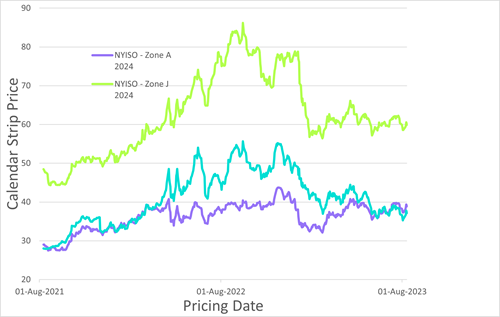Smartest Insight | Issue 130

Our weekly company round-up covers the key market and industry news in one place, so you don’t have to look any further to stay ahead.
August 11, 2023
Market Update:
The EIA reported a storage injection of +29 Bcf for the week ending August 4th. This is +4 Bcf higher than expectations. This is 21.4% higher than a year ago and 11.2% higher than the 5-Yr average. Storage inventories are now at 3,030 Bcf.
Prompt month NG dipped near $0.20/MMBTU on the day to $2.75/MMBTU, which is a 6.6% decrease from yesterday's close. The rest of the curve followed suit with a 3% average decrease.
Natural gas production has averaged 102 BCF per day. This is +6 BCF higher when compared to the first half of 2022. The EIA forecasts the average daily production to be 104 BCF per day through the end of 2024. This is driven by continued gas and oil drilling currently occurring, especially in the Permian Basin. By the end of October, NG in storage is expected to increase to 3,900 BCF which is 7% higher than the 5-Yr average. Storage is expected to stay above the 5-Yr average through 2024 due to the high NG production and lower demand projections.

Regulatory Report:
NYISO Proposing Changes to Demand Curves
The New York Independent System Operator (NYISO) is proposing changes to how it calculates power prices to ensure a stable electricity supply. They want to have separate curves for summer and winter, starting from 2025/2026. This means they will consider different costs for each season. NYISO is adjusting how they decide the prices to make sure they account for the risk of power shortages in each season. They want to be careful with the changes and are using past data to set initial values.
Every year, the New York State Reliability Council decides the minimum power capacity needed to handle high demand. For example, they recommended having 20% more power available than the highest demand in 2023. NYISO wants to improve how they calculate prices based on this requirement. They also want to consider changing the calculation for the maximum clearing price to ensure that the maximum clearing price is greater than the seasonal reference point.
NYISO is planning to update their tariff to include these changes. They are asking for people's opinions on the new rules and plan to discuss the feedback in meetings before finalizing everything. The goal is to have the new rules approved by stakeholders between September and October.
EV Gets Support from Governor Hochul
New York Governor Kathy Hochul has introduced a $12 million plan to boost electric vehicle (EV) use and improve the power grid. The initiative aims to encourage the adoption of EVs and support demonstrations of medium- and heavy-duty electric and hydrogen fuel cell technologies. Hochul stated that this approach helps make clean transportation more affordable and strengthens the energy grid's resilience. The initiative aligns with New York's goal of achieving zero-emission vehicles by 2035 and a zero-emission power sector by 2040, part of efforts to reduce greenhouse gas emissions by 85% by 2050.
The program will be managed by the New York State Energy Research and Development Authority and includes several objectives: advancing EV charging infrastructure, making EV ownership economically feasible for individuals and businesses, promoting innovative research for beneficial EV-grid integration, and showcasing medium- and heavy-duty vehicle electrification.
The initiative will award up to $3 million for projects that reduce peak power demand and provide grid benefits by improving charging and discharging practices. It's anticipated that this effort will increase the use of existing power grid infrastructure and demonstrate electric and fuel cell vehicles in challenging scenarios, such as heavy-duty vehicles and construction equipment.
Concept papers for the initiative can be submitted until September 12, and funding comes from New York's $6 billion Clean Energy Fund, which spans a 10-year period. The state has also taken steps towards a zero-emission future, with plans for all new cars and trucks sold to be emissions-free by 2035 and all school buses to follow suit.
